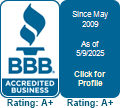
You shouldn’t have to sacrifice comfort or empty your wallet to keep your residence at a refreshing temperature during hot days.
But what is the ideal temp, exactly? We go over suggestions from energy experts so you can find the best temperature for your home.
Here’s what we recommend for the most energy-efficient setting for air conditioning in West Valley City.
Recommended Thermostat Settings for Summer
Most households find placing the thermostat at 72-73 degrees provides ideal comfort. However, if there’s a huge difference between your inside and outside temps, your AC costs will be larger.
These are our recommendations based on the U.S. Department of Energy (DOE) and ENERGY STAR®.
While at home: 78 degrees. While that appears warm, there are ways you can keep your residence cool without having the air conditioning going frequently.
Keeping windows and window treatments down during the day keeps cool air where it should be—inside. Some window coverings, including honeycomb shades or plantation shutters, are created to provide added insulation and enhanced energy conservation.
If you have ceiling fans in your residence, the DOE says you can increase thermostat settings about 4 degrees hotter without compromising comfort. That’s since they refresh with a windchill effect. Because they cool people, not areas, shut them off when you leave a room.
If 78 degrees still feels too uncomfortable initially, try conducting a trial for a week or so. Get started by raising your setting to 78 degrees while you’re at your residence. Then, steadily decrease it while using the tips above. You may be astonished at how comfortable you feel at a warmer temperature setting.
While away: 88 degrees. There’s no need to keep the air conditioner on all day while your residence is unoccupied. Switching the temp 7–10 degrees higher can save you anywhere from 5–15% on your AC bills, according to the DOE.
When you arrive home, don’t be tempted to put your thermostat colder than 78 to cool your residence faster. This isn’t effective and usually produces a bigger cooling expense.
A programmable thermostat is a helpful approach to keep your settings under control, but you have to set programs. If you don’t set programs, you risk forgetting to move the set temperature when you take off.
If you need a handy remedy, think about getting a smart thermostat. This thermostat works with with your phone, so it is aware when you’re at home and when you’re away. Then it instinctively changes temperature settings for maximum savings. How much exactly? Typically $180 each year on heating and cooling, according to ENERGY STAR.
Another plus of getting a smart thermostat? You can use your phone to monitor and regulate temperature settings from nearly anywhere.
While sleeping: Around 70 degrees. While ENERGY STAR suggests 82 degrees, that could be too uncomfortable for most families. Most people sleep better when their sleeping space is chilled, so that’s why the National Sleep Foundation suggests 60–67 degrees. But that might be too cold, based on your pajama and blanket preference.
We recommend running a similar test over a week, moving your thermostat higher and slowly turning it down to choose the ideal setting for your residence. On cool nights, you might find keeping windows open at night and relying on a ceiling fan is a preferable idea than running the air conditioning.
More Methods to Save Energy During Warm Weather
There are added ways you can save money on utility bills throughout warm weather.
- Get an energy-efficient AC system. Central air conditioners only are effective for about 12–15 years and get less efficient as they become older. An upgraded air conditioner can keep your residence more comfortable while keeping AC bills small.
- Schedule yearly air conditioner maintenance. Regular air conditioner maintenance keeps your equipment running like it should and might help it run more efficiently. It might also help lengthen its life expectancy, since it allows techs to uncover small issues before they cause a major meltdown.
- Change air filters often. Follow manufacturer instructions for switching your air filter. A clogged filter can cause your system to short cycle, or switch on and off too much, and increase your energy.
- Check attic insulation levels. Almost 90% of homes in the USA don’t have proper insulation, according to the Insulation Institute. Many southern climates require 13–14” of attic insulation, while northern climates need 16–18”.
- Have your ductwork examined. Ductwork that has separated over time can leak cold air into your attic, walls or crawl space. This can result in big comfort troubles in your house, like hot and cold spots.
- Seal openings, doors and windows. Keep warm air where it should be by closing openings. You can also caulk or weather strip doors to keep more cold air within your home.
Save More Energy During Warm Weather with Select Comfort Systems
If you are looking to save more energy this summer, our Select Comfort Systems pros can help. Reach us at 801-305-4777 or contact us online for extra info about our energy-saving cooling products.

